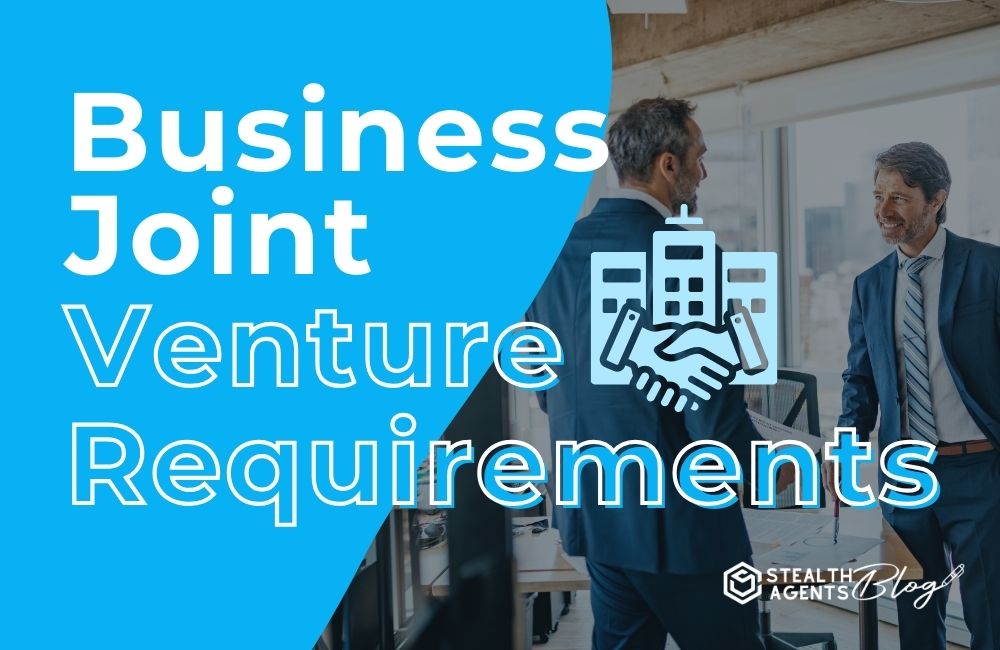This blog post aims to demystify the concept of business joint ventures and outline the essential requirements for crafting a partnership that stands the test of time.
We’ll explore what a JV is, why businesses enter into these agreements, and the crucial steps and considerations involved in forming one.
By the end, you’ll have a clear understanding of how to create a successful joint venture.
So, partner with an appointment setting skills that aligns with your business goals.
Employ Stealth Agents to handle tasks and optimize the productivity of your business.
Discover our various pricing options on the page.
What is a Business Joint Venture?
A joint venture (JV) is a strategic alliance where two or more parties pool their resources to achieve a specific goal while remaining independent entities. Typically, each party contributes assets, capital, expertise, or other resources.
The primary objective of a joint venture is to leverage the strengths of each partner to accomplish a task that might be too complex or resource-intensive to do alone. This could range from developing new products to entering international markets.
A joint venture can take various forms, including contractual joint ventures, equity joint ventures, and partnerships. Understanding these differences is crucial for selecting the structure that best suits your needs.
Why Businesses Opt for Joint Ventures
Joint ventures offer several advantages that make them an attractive option for businesses of all sizes.
Firstly, they provide access to new markets and distribution networks. By partnering with a local entity, you can tap into their market knowledge and customer base, reducing the risks associated with foreign expansion.
Secondly, joint ventures allow for shared risks and costs. By pooling resources, both partners can undertake projects that would be too costly or risky on their own.
Lastly, joint ventures facilitate the sharing of expertise and technology. Each partner brings unique skills and intellectual assets to the table, fostering innovation and improving operational efficiencies.
Legal Frameworks and Formal Agreements
One of the first steps in setting up a joint venture is drafting a comprehensive legal agreement. This document serves as the blueprint for the partnership, outlining each party’s responsibilities, contributions, and expectations.
Key elements of a joint venture agreement include the objectives of the JV, governance structures, profit-sharing ratios, and exit strategies. It’s essential to consult legal experts to ensure that the agreement complies with local laws and regulations.
Additionally, it’s crucial to define the legal structure of the JV. Options include forming a new entity or operating under a contractual agreement. Each has its pros and cons, depending on your specific goals and circumstances.
Defining Clear Objectives and Goals
Successful joint ventures are built on well-defined objectives and goals. Both parties need to clearly understand what they aim to achieve through the partnership.
Start by outlining short-term and long-term goals. For example, short-term goals might include market penetration or product development, while long-term goals could focus on revenue growth or brand fortification.
It’s also important to establish key performance indicators (KPIs) to measure the JV’s progress. These metrics will help you track performance and make necessary adjustments along the way.
Identifying the Right Partners
Choosing the right partner is perhaps the most critical factor in the success of a joint venture. The ideal partner should complement your business’s strengths and fill in gaps where you may lack expertise or resources.
*advertisement*
Tired & Overwhelmed With Administrative Tasks?
Hire A Top 1% Virtual Assistant From Stealth Agents!

Sign Up Below & Hire A Top 1% Virtual Assistant
Rated 4.7 Stars Serving Over 2,000+ Customers.
Hire Top 1% Virtual Assistants For $10-$15 Per Hour
Ask About Our 14 Day Trial!
*advertisement*
Conduct thorough due diligence to assess potential partners’ financial stability, market reputation, and cultural compatibility. The more aligned your values and business practices are, the smoother the partnership will be.
A detailed vetting process helps mitigate risks and sets the stage for a successful collaboration.
Resource Allocation and Contribution
Both parties must agree on the resources each will contribute to the joint venture. These resources could range from capital and intellectual property to workforce and technology.
Clearly defining each partner’s contributions ensures transparency and helps prevent conflicts down the line. It also provides a solid foundation for measuring each partner’s return on investment.
An equitable resource allocation plan aligns the interests of both parties and facilitates smoother operations.
Governance and Management Structures
Effective governance is vital for the smooth functioning of a joint venture. Establishing a robust management structure ensures that decision-making processes are transparent and accountable.
Typically, a JV will have a Board of Directors or a steering committee with representatives from each partner. These bodies oversee the JV’s strategic direction and resolve any disputes that may arise.
Clear governance structures help maintain focus and ensure that the JV operates efficiently and ethically.
Risk Management and Contingency Planning
Every business endeavor carries risks, and joint ventures are no exception. Identifying potential risks and developing contingency plans is crucial for mitigating unforeseen challenges.
Conduct a risk assessment to identify possible threats, such as market volatility, regulatory changes, or operational inefficiencies. Once identified, develop strategies to manage these risks effectively.
Having a well-documented risk management plan provides a safety net and ensures that both partners are prepared for any eventualities.
Financial Planning and Profit Sharing
Financial planning is a critical component of any joint venture. Both parties need to agree on how profits and losses will be shared.
Establish clear guidelines for profit distribution, taking into account each partner’s contributions and the agreed-upon profit-sharing ratios. It’s also essential to outline how funds will be reinvested into the venture for future growth.
Transparent financial planning fosters trust and ensures that both partners are fairly compensated.
Marketing and Sales Strategies
A well-thought-out marketing and sales strategy is essential for the success of a joint venture. Both parties should collaborate to develop a unified approach to market the JV’s products or services.
Leverage each partner’s existing marketing channels and customer base to maximize reach and impact. Develop a cohesive brand message that aligns with the JV’s objectives and resonates with the target audience.
Effective marketing and sales strategies drive growth and enhance the JV’s market presence.
Communication and Collaboration
Open and transparent communication is the backbone of a successful joint venture. Establishing regular communication channels helps keep both parties aligned and informed.
Schedule regular meetings to discuss progress, address challenges, and make strategic decisions. Utilize collaborative tools and platforms to streamline communication and enhance productivity.
Strong communication fosters a collaborative culture and ensures that both partners work towards common goals.
Exit Strategies and Termination Clauses
No joint venture lasts forever, and having a clear exit strategy is essential for a smooth transition when the partnership ends.
Outline termination clauses in the JV agreement, specifying conditions under which the venture can be dissolved. This could include achieving the JV’s objectives, mutual agreement, or unforeseen circumstances.
Having a well-defined exit strategy ensures that both parties can disengage amicably and without legal complications.
Measuring and Evaluating Success
Continuously measuring and evaluating the joint venture’s performance is crucial for long-term success. Regularly review KPIs and assess whether the JV is meeting its objectives.
Conduct periodic performance audits to identify areas for improvement and make necessary adjustments. This proactive approach ensures that the JV remains on track and achieves its goals.
Evaluating success helps both partners learn from the experience and apply insights to future collaborations.
Building Long-Term Relationships
A successful joint venture can pave the way for long-term relationships and future collaborations. Both parties should focus on building trust and maintaining a positive working relationship.
Celebrate milestones and successes together, and address challenges with a collaborative mindset. Strong relationships enhance the potential for future joint ventures and other strategic partnerships.
Building long-term relationships ensures that both parties continue to benefit from the partnership even after the JV has ended.
Conclusion
Joint ventures offer a powerful strategy for businesses looking to achieve specific goals through collaboration. By understanding the essential requirements and following best practices, you can set up a joint venture that drives growth, innovation, and success.
Remember, the key to a successful joint venture lies in choosing the right partner, defining clear objectives, and maintaining open communication. With these elements in place, your joint venture is poised for success.










